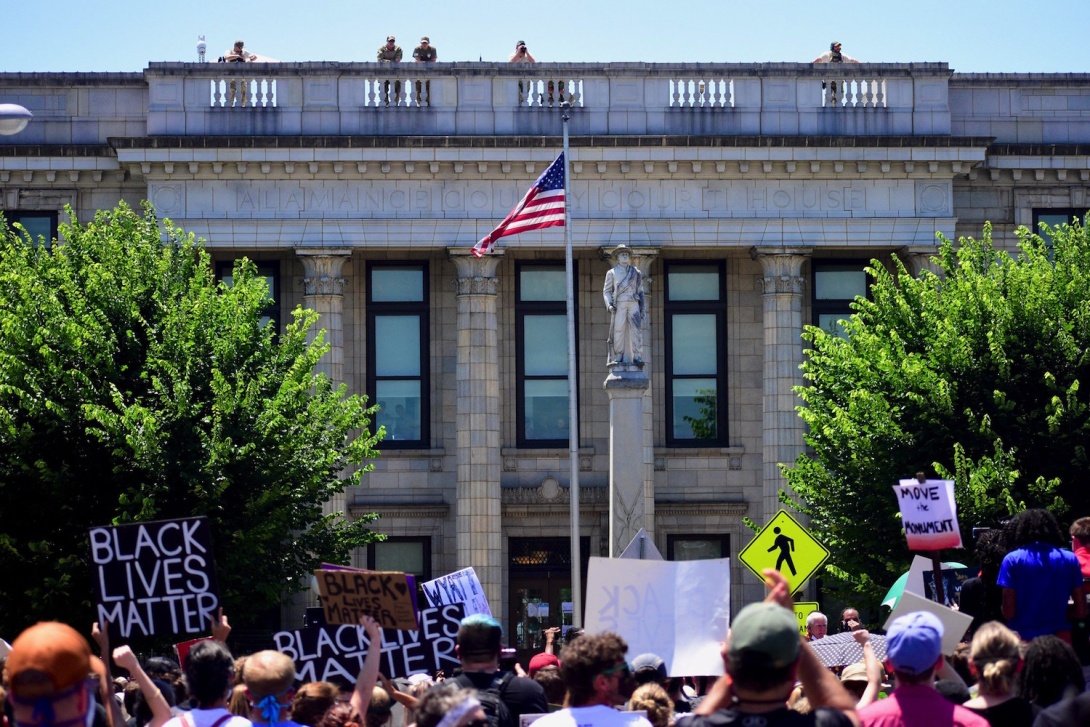A new push to remove Confederate monuments from North Carolina courthouses

A Confederate monument outside the historic Alamance County Courthouse in Graham, North Carolina, is among those that have been targeted for removal by racial justice protesters. (Photo by Anthony Crider via Flickr.)
In counties around the South, people entering their local courthouse must walk by monuments to the soldiers who defended the Confederate slavocracy. Dozens of these statues were placed on courthouse lawns in North Carolina, mostly in the early years of Jim Crow, and a new campaign seeks to empower activists to pressure local officials to take them down.
The North Carolina Commission on Racial and Ethnic Disparities in the Criminal Justice System (NC CRED) launched its campaign on Feb. 14, the birthday of abolitionist Frederick Douglass. James Williams, the head of NC CRED and a longtime public defender in North Carolina, said that courthouse lawns "are the last place these monuments should be located."
Putting the statues at courthouses, like they're "guarding the entrance," sends a message, said Williams. "The message is one of terror and oppression of Black people," he said. "The statues honor the legacy of slavery and white supremacy."
Created in 2013, NC CRED grew out of an earlier project in which a team of lawyers, officials, activists, and scholars studied traffic stops by police. They found that Black drivers were much more likely to be pulled over and charged with minor traffic infractions. They wrote to the leaders of all three branches of North Carolina's government, informed them of the disproportionate impact on Black drivers, and asked them to send representatives to serve on a new organization, NC CRED.
The group said its purpose was to provide more research into "the disparate representation within our criminal justice system, and, where necessary, to take effective action to eliminate race-based disparities." Since then, NC CRED has worked with local and state officials to expose and address disparities in sentencing and other aspects of the justice system.
As part of its latest campaign, NC CRED has counted 42 monuments at courthouses around the state, in addition to around 150 in other public places. Many of them were erected after Reconstruction, as Jim Crow was tightening its grip on the South. But a handful of statues were put up in the last 20 years.
In May 2003, for example, a new Confederate statue was raised outside the historic Gaston County courthouse and dedicated to 1,500 men from the county who "answered the call of their state and country to defend the South in the war between the states." It joined another Confederate statue that was erected in 1912 outside the county courthouse and was relocated in 1998 when the court moved to its current location on Martin Luther King Avenue in Gastonia.
Among the speakers at the original statue's 1912 dedication was former N.C. Attorney General Thomas Bickett, who would soon be elected governor. He praised white supremacy: "North Carolina holds in trust, for the safety of the nation, the purest Anglo-Saxon blood to be found on American shores."
The Gaston County Commission voted to remove the 1912 monument last year, but the Sons of Confederate Veterans refused to take ownership of it. This led the commission to rescind its decision just a few weeks later. The local NAACP and others then sued the county, alleging a violation of the state constitution's ban on racial discrimination.
Most of North Carolina's courthouse monuments were erected in the early 20th century. They include a 30-feet-tall obelisk topped by a Confederate soldier outside the Alamance County Courthouse in Graham, North Carolina, which stands just feet away from the site where a Black leader named Wyatt Outlaw was lynched in 1870.
For years, Black Lives Matter protesters in Graham have been demanding that local authorities take down the statue. Protesters rallying against police brutality and discrimination have frequently faced off there against a group of statue supporters waving Confederate flags. Last November, hundreds of voters taking part in a rally and march to a polling station at the courthouse were pepper sprayed by Graham police because they blocked the road for about 10 minutes.
NC CRED's website includes an interactive map with information on each courthouse statue and a link for contacting local officials. It also provides links to resources like the Southern Poverty Law Center's community action guide. Williams said that NC CRED would connect activists with lawyers and historians to support efforts to take down the statues.
Across the South in recent years, protesters or local officials have removed well over 100 Confederate statues from public spaces. Earlier this month, two Confederate statues were taken down in Georgia — one that had been installed in 1993 at the Gwinnett County Courthouse in Lawrenceville, and the other a 1912 statue of a Confederate general that was relocated from downtown Dalton to a historic house that served as a Confederate Army headquarters.
During last summer's Black Lives Matter protests in North Carolina's capital city of Raleigh, several Confederate monuments, including a 75-foot-tall obelisk, were defaced by protesters and eventually removed from the grounds of the historic state capitol. A few weeks later, North Carolina court officials removed a statue of former state Supreme Court Chief Justice Thomas Ruffin, a notoriously brutal enslaver whose opinions sanctioned brutality by other enslavers, from the entrance to the building that housed the North Carolina Court of Appeals — a move long urged by NC CRED and other racial justice advocates. Earlier this year, Ruffin's portrait was also removed from a place of prominence behind the state Supreme Court's bench.
A 2015 law passed by North Carolina's Republican-controlled state legislature prohibits the removal of Confederate monuments without the permission of a state agency. However, some local officials have cited the law's exception for public safety reasons when taking down statues that have been targeted by protesters.
"For generations now, Black residents have been bitterly welcomed by these symbols that include monuments, murals, portraits, and other racist iconography," said Rev. T. Anthony Spearman, president of the North Carolina NAACP and an NC CRED member. "Removing the monuments will not erase history. Instead, it will create history as we endeavor to right the wrongs of what they represent. We're encouraged by the monuments that have been removed thus far, and hopeful that every single one of them will be removed."
Tags
Billy Corriher
Billy is a contributing writer with Facing South who specializes in judicial selection, voting rights, and the courts in North Carolina.
